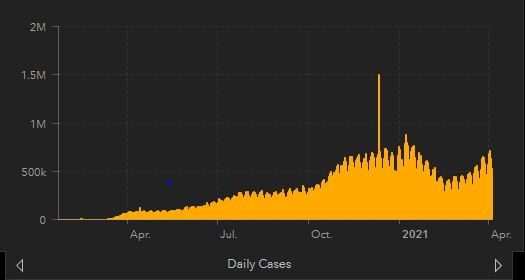Pandemicia coronavirus report #55
Epidemic
Global report
The Global daily cases graph shows the wave structure of the pandemic is not exactly as thought. There was actually a single wave (with three intermediate waves, broken by plateaux) up to January 7 when global infections topped at 800,000 per day, after which infections fell for the first time until Feb 15,
The progress of daily cases has been affected by the slow startup in testing, and the early impact of the pandemic is underestimated by confirmed cases. The long stationary positions in confirmed cases were set by the global availability of testing kits rather than the progress of the disease, where daily deaths or hospitalizations give a better picture (though lagged by several weeks). Here, much more clearly, there have been two 'waves', the first topping in April, the second in January 2021. dropping about 50% before embarking on a new wave.
The current rise, which may exceed the previous, is strongest throughout Latin America, where many countries have reached substantial new highs (Brazil reaching 100.000 a day, about the same as USA). India is also nearing 100,000 per day, Bangladesh, Pakistan and Philippines are in the grip of major second waves, and Canada is into a third wave. Cambodia and Papua are fighting epidemics for the first time. In Europe, France has a near-record 75,000 cases per day and Italy, Germany and Netherlands are high, though Britain, Spain, Switzerland and Portugal have fallen to relatively low levels.
Papua New Guinea has now been overwhelmed by the virus, with morgues full and hospitals without beds. The confirmed cases data are inadequate, since one in five tests are coming back positive. The young population nay have allowed the disease to spread undetected - a lesson for other developing nations. Australia is trying to wangle 1 million vaccines for PNG from Europe, but these are being tightly held.
The second wave in East-central Europe appears to have topped. Due to the intensive vaccination programme, Israel looks to have beaten the virus - the first new country to do so since Uganda in February. Zimbabwe also seems to have quelled the virus, temporarily at least.
By all appearances, the pandemic is set to go on for another year or so.
Response
Vaccine
Further evidence has mounted that the Astrazenica virus may be associated with blood clotting in a small number of individuals (1 in 100,000 injections has been estimated). The clotting is different to typicl thrombosis, and is driven by the immune system. 169
cases have been reported among 34 million people who have had the jab.
15 million doses of Johnson and Johnson vaccine had to be discarded when a secondary manufacturer in Baltimore accidentally substituted Astrazenica components. Johnson and Johnson have now taken iover the plant and Astrazenica production has moved elsewhere.
The CDC has announced that travel is 'low risk behaviour' for the fully inoculated.
There has been some argument over whether vaccine delivery through high-volume sites or evenly through the medical profession is better. The rollout in Australia has proceeded through GPs and has been very slow and uneven, with only 2% of the adult population vaccinated compared with 30% in the USA and 70% in Israel. This is probably not so urgent with COVID virtually eliminated in Australia.
15 million doses of Johnson and Johnson vaccine had to be discarded when a secondary manufacturer in Baltimore accidentally substituted Astrazenica components. Johnson and Johnson have now taken iover the plant and Astrazenica production has moved elsewhere.
The CDC has announced that travel is 'low risk behaviour' for the fully inoculated.
There has been some argument over whether vaccine delivery through high-volume sites or evenly through the medical profession is better. The rollout in Australia has proceeded through GPs and has been very slow and uneven, with only 2% of the adult population vaccinated compared with 30% in the USA and 70% in Israel. This is probably not so urgent with COVID virtually eliminated in Australia.
Other
The chief executive of restaurant chain Texas Roadhouse committed suicide while suffering from post-COVID symptoms, mostly severe tinnitis. He had given up his base salary, bonuses and about $5m to help his frontline workers.
There are a significant number of COVID 'long haulers' who continue to experience symptoms for between six weeks to five months after infection, though they were not hospitalised. Most of these are reporting 'brain-related' symptoms.
Geopolitical
Borders have been opened for travel between Australia and New Zealand, subject to fairly stringent adherence to tracing guidelines. Travel may leave travellers vulnerable to being trapped on thewrong side of the Tasman in the event of lockdown.
US President Joe Biden detailed plans to increase the US corporate tax rate, which applies to all US companies, from 21 to 28 per cent to help fund his $2.5 trillion infrastructure plan. This may reverse the global trend toward lower corporate tax rates, which rather that the 'road to prosperity' as some promised, have been a road to massive inequality and unfair tax burdens,
Economy
Five profitable major companies paid back all their Jobkeeper subsidies in Australia, and 28 more repaid part.
Female workforce participation in the USA has dipped to 57%, the lowest it has been in three decades.
International students in Australia are among those hit hardest by the pandemic. Most have lost jobs or have had hours reduced. About 20,000 may be 'hot-bedding' or sharing beds for certain hours.
International students in Australia are among those hit hardest by the pandemic. Most have lost jobs or have had hours reduced. About 20,000 may be 'hot-bedding' or sharing beds for certain hours.



Comments
Post a Comment